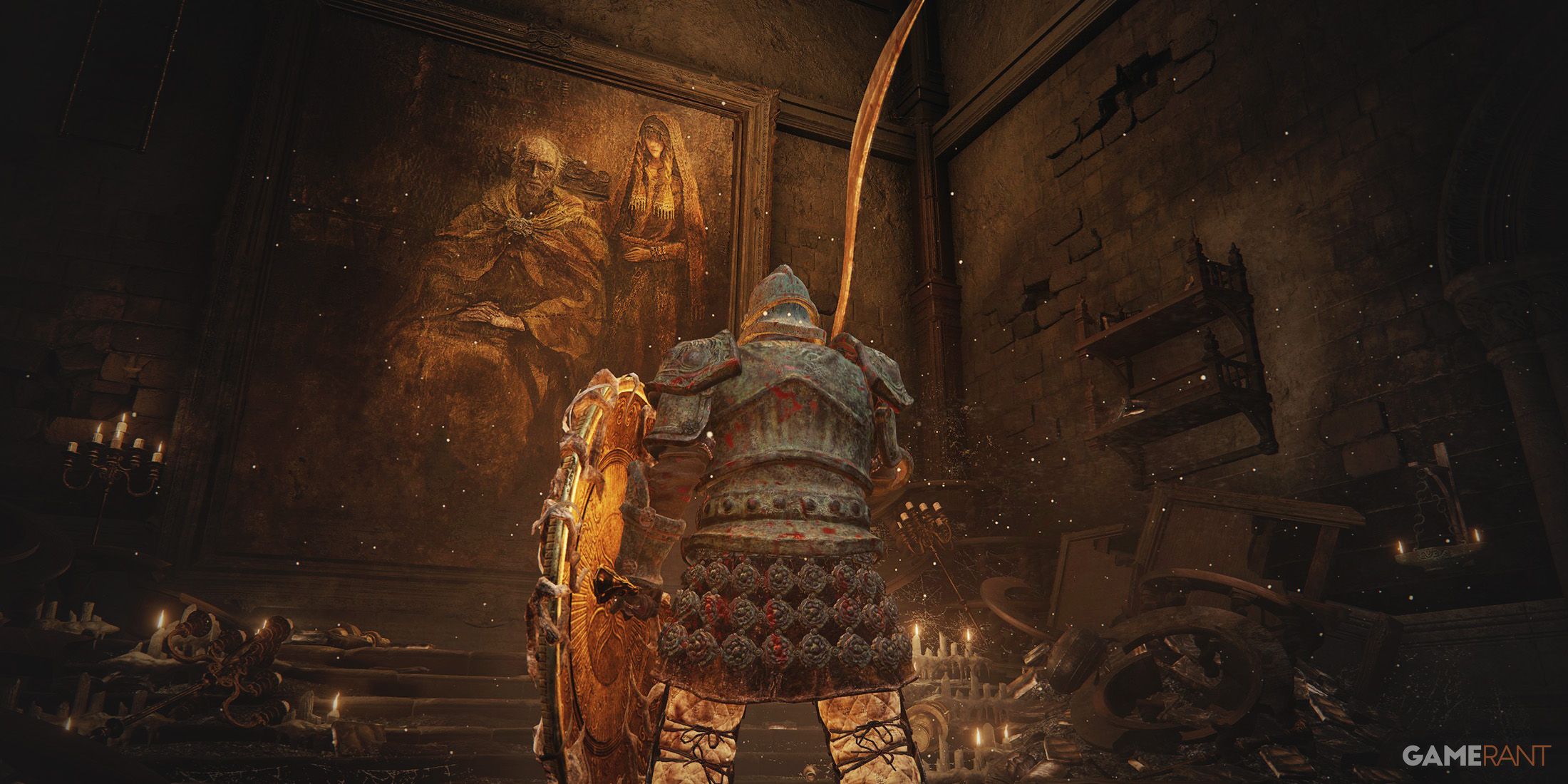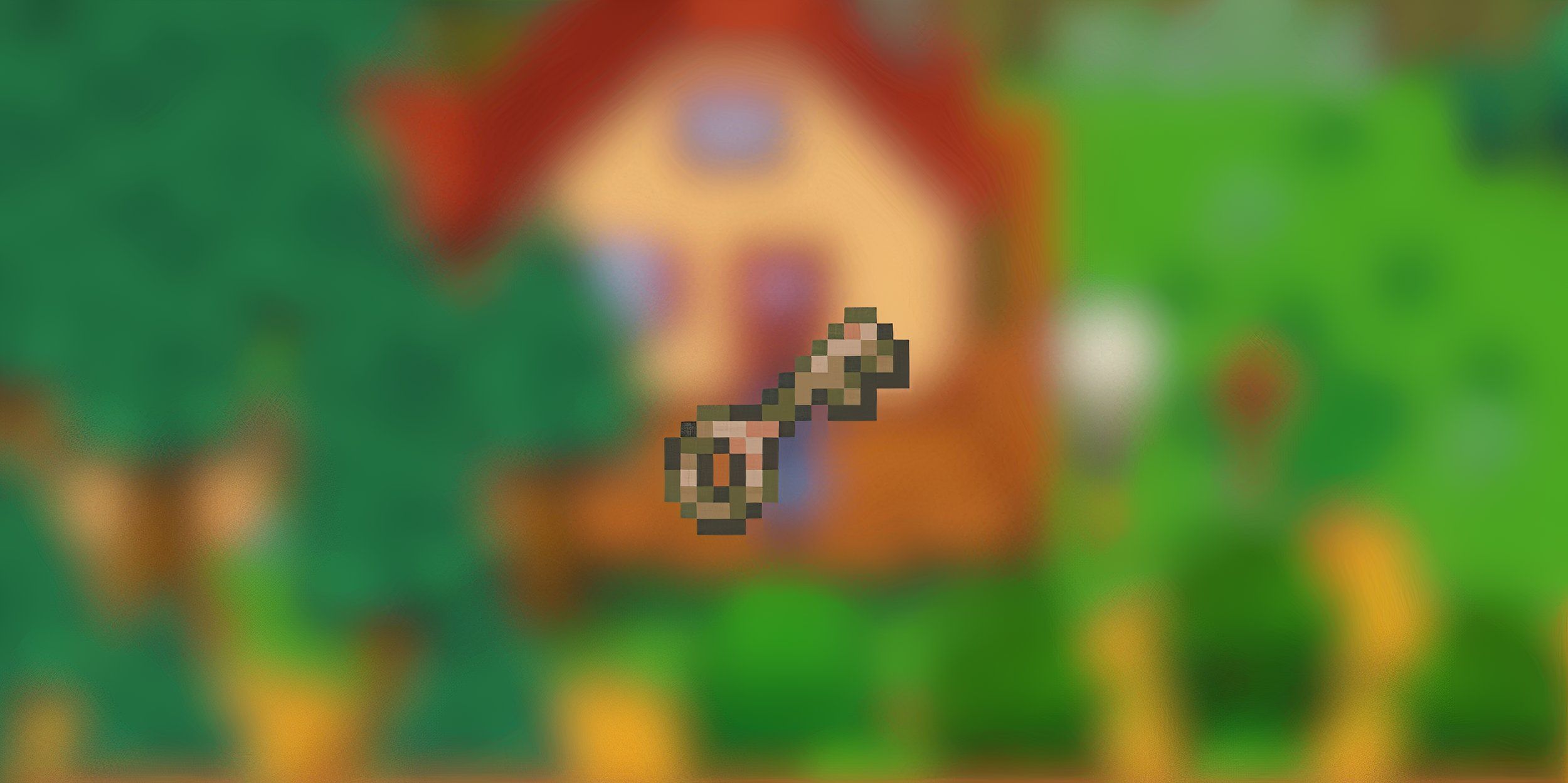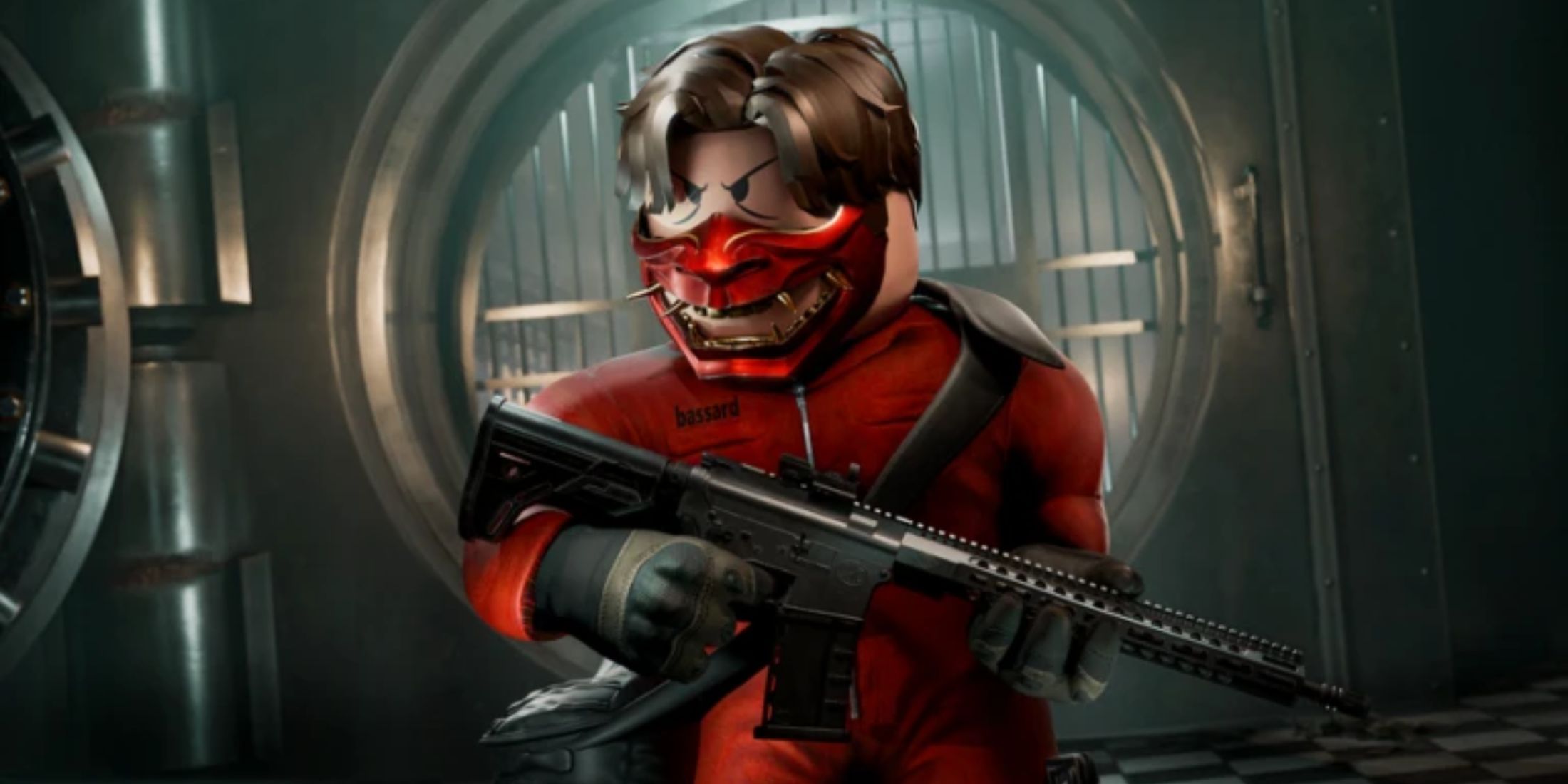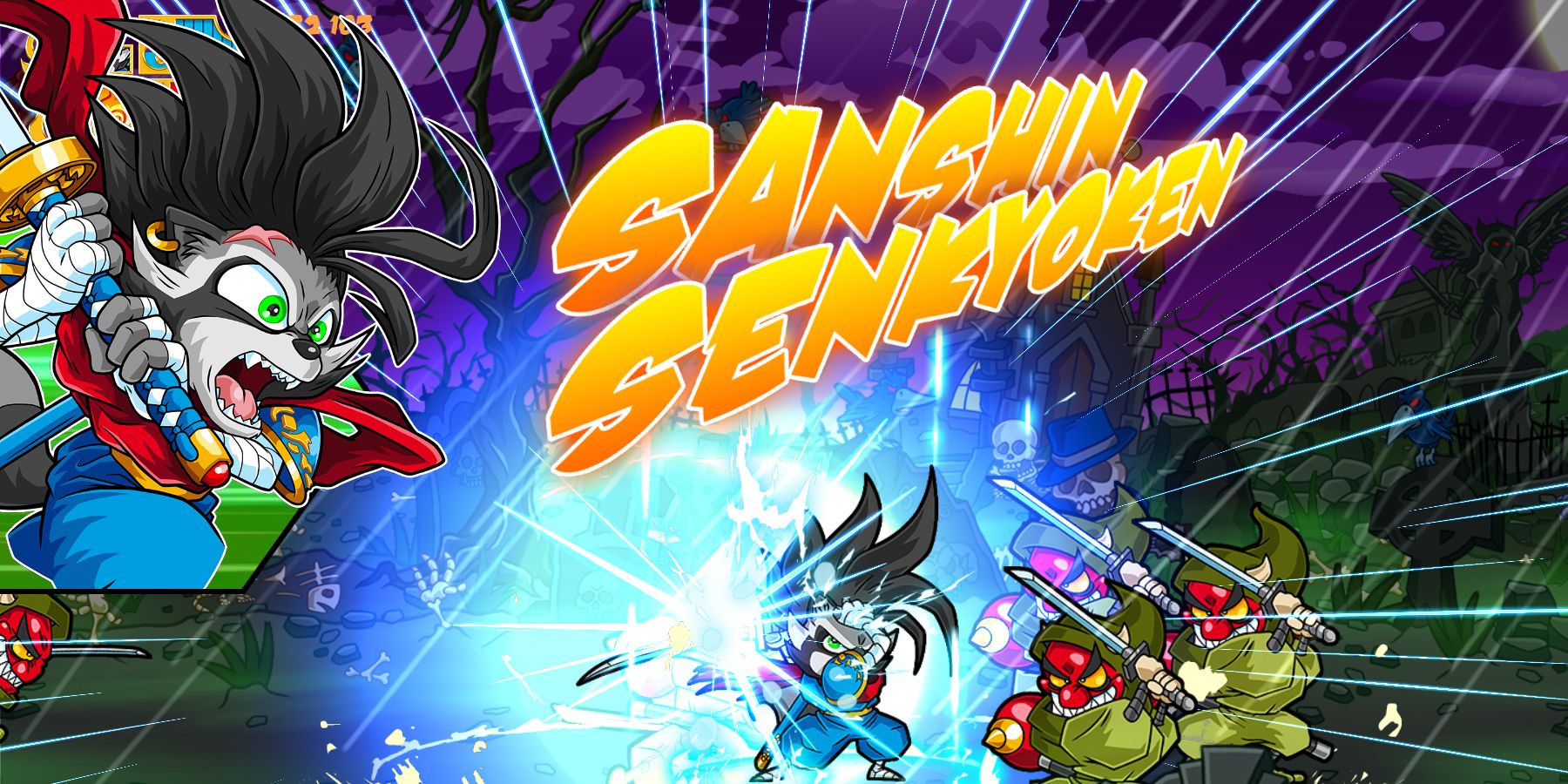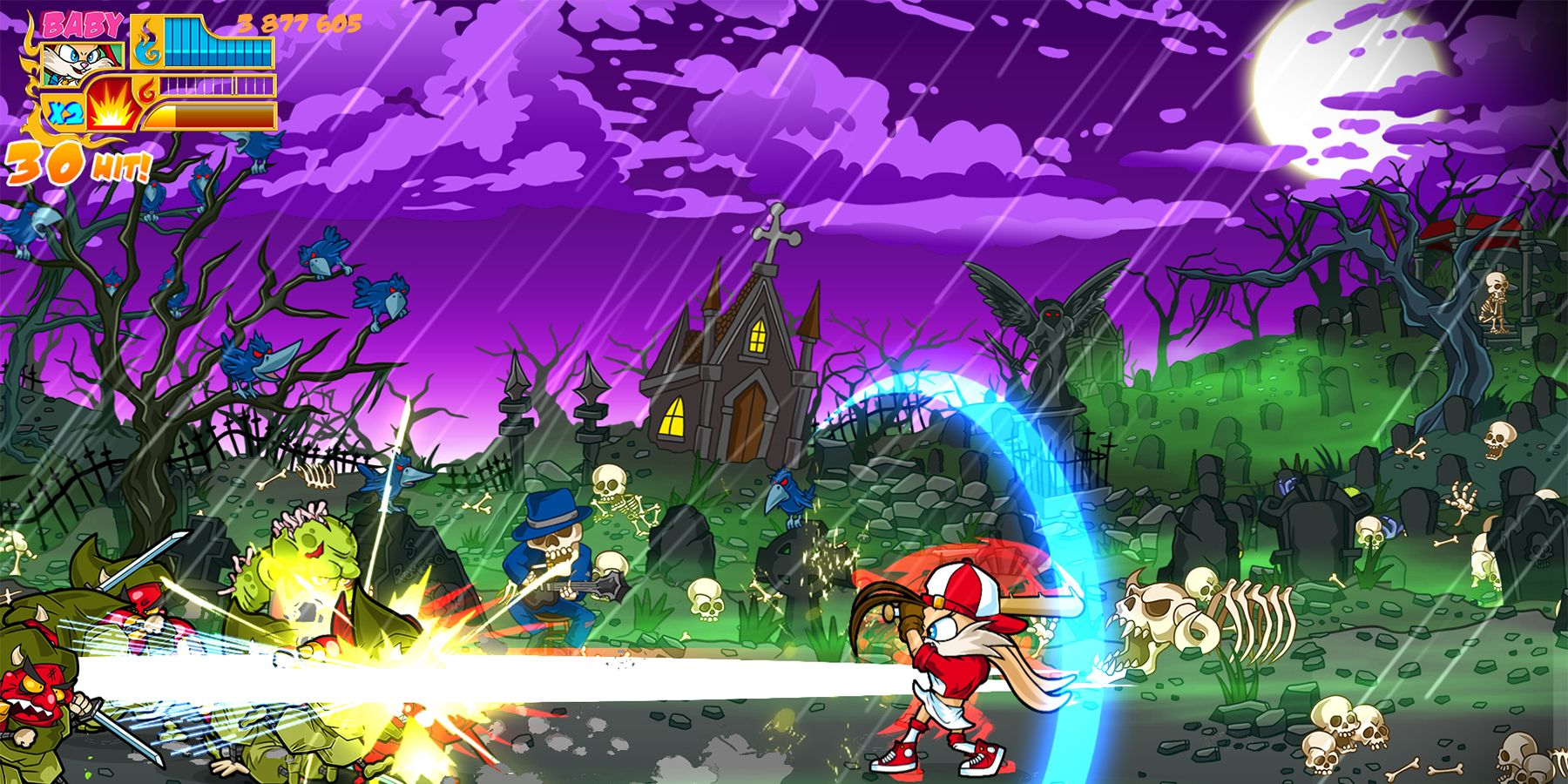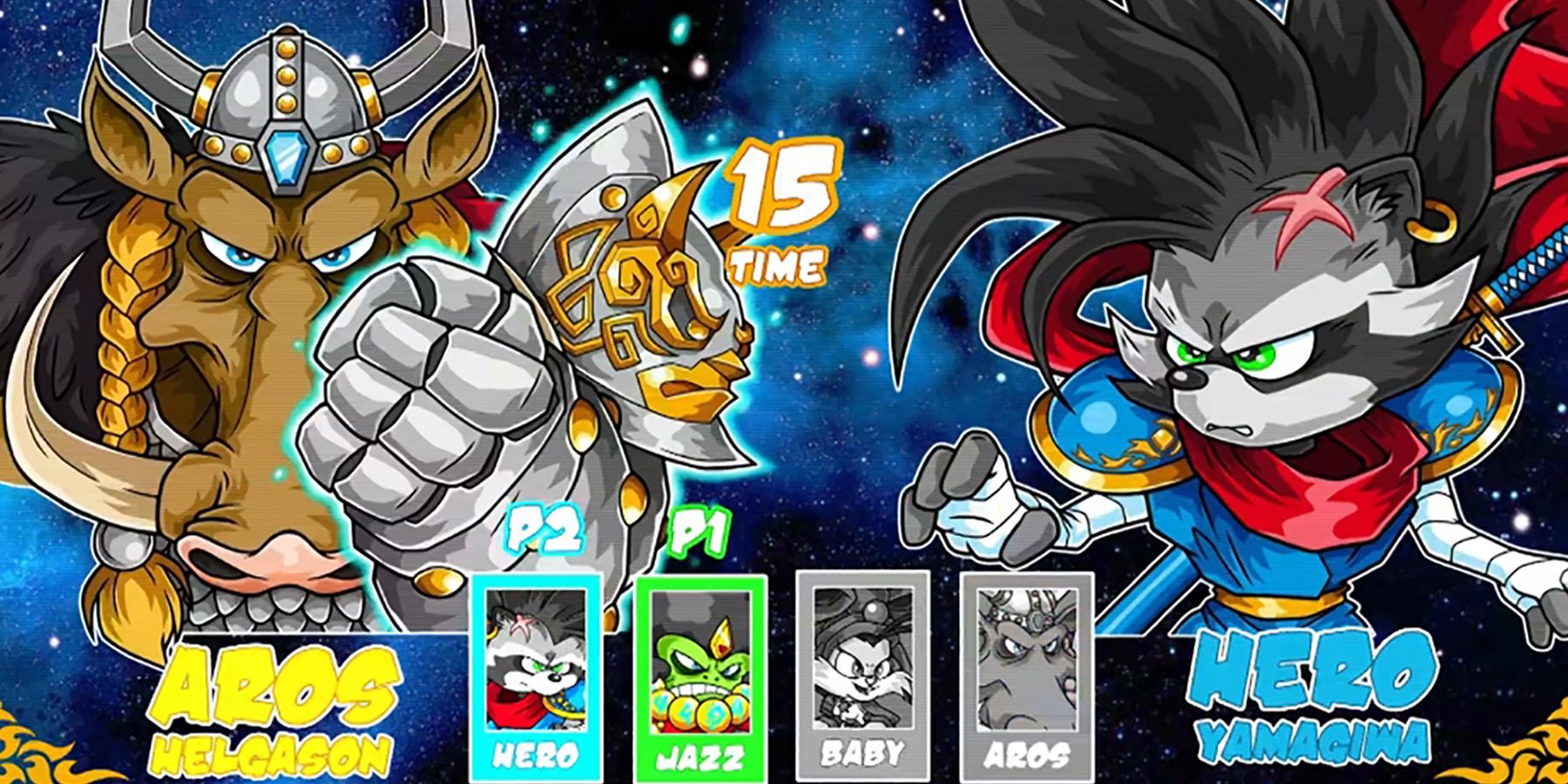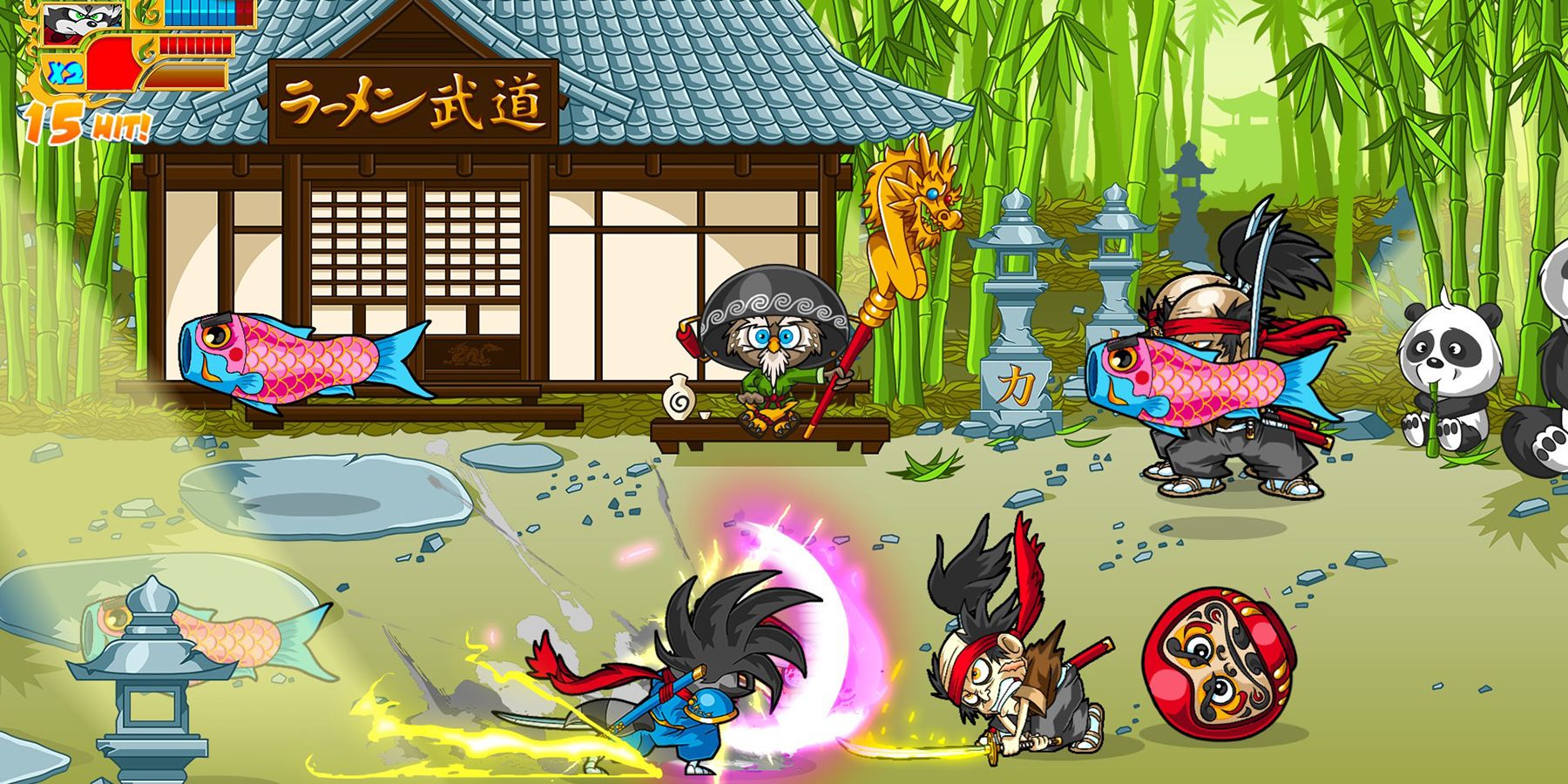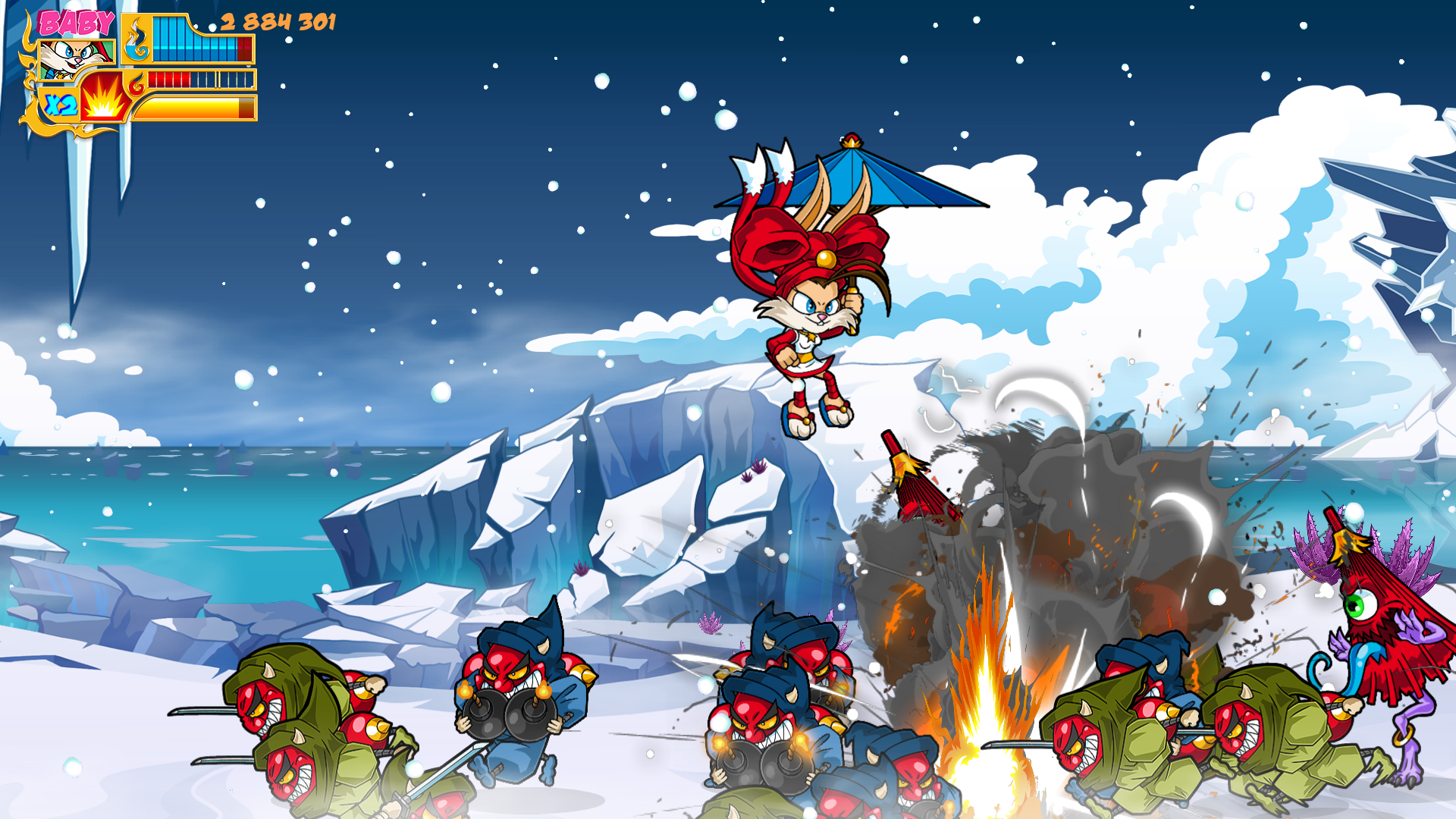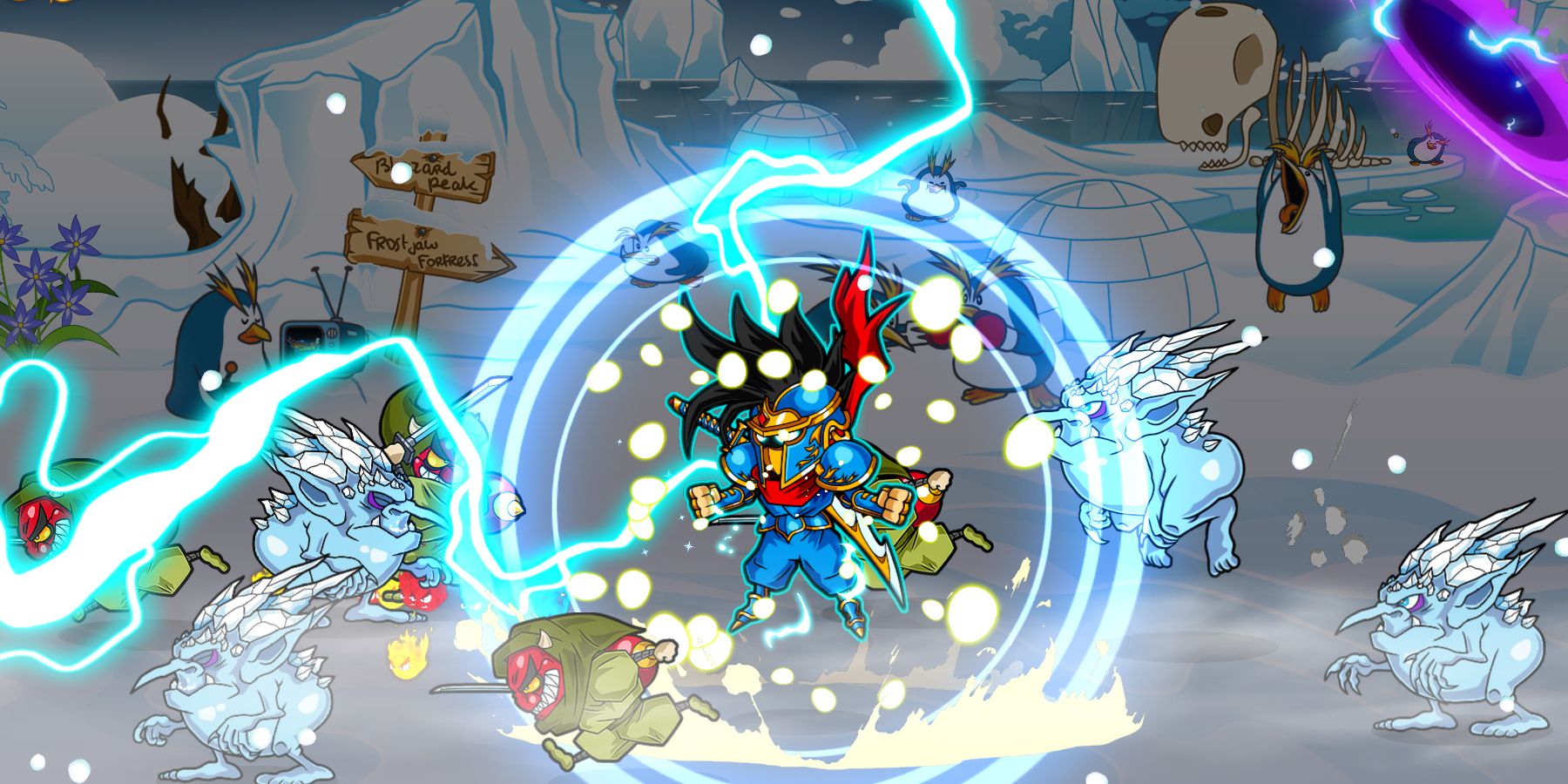Jitsu Squad, Tanuki Creative Studios' first game, is at once a bombastic four-player beat 'em up, a love letter to anime, and a celebration of 1990s video game culture. The indie game recently dropped on Steam to favorable reviews, and is set to launch for consoles later this year.
Game ZXC spoke with the creators Dave Baljon and Sebastien Romero about Jitsu Squad, its long development, and their influences. Interview has been edited for clarity and brevity.
Q:Can you introduce yourself and share your favorite beat ‘em up game?
Romero: My name is Sebastien Romero. I am the composer and the animator for Jitsu Squad. I started working with Dave around 2016 and yeah, we've been working together ever since.
My favorite beat ‘em up... Let's see. I really, I really love Streets of Rage 2 because of the music. But I think I'd prefer Ninja Baseball Bat Man because it is so hectic. The speed of the action. It’s very fast for a beat ‘em up. River City Ransom is another one of my favorites. I like the original NES version, but I also really liked the newer version released on the Nintendo DS. The interactions between characters were really revolutionary on the NES.
Baljon: I'm Dave. I started Jitsu Squad a long time ago, somewhere around… I think it was the beginning of 2015. I started making designs, drawings, and everything. And then Sebastian and I met each other at a birthday, and he saw what I did. He saw the artwork and said, “you know what? I know how to animate and these drawings would look pretty cool in motion.” And I have no background in animation whatsoever. So from there we just tried working together and decided to see how things turn out.
We did this for about two years. Since 2016. We both had a day job actually, and on two days a week, on Monday and Tuesday, we would work on Jitsu Squad. Of course, we also did a lot in the evenings and over the weekend. And then in 2018, we were lucky enough to find a publisher after a long search and not giving up. It was amazing to quit what we were doing and then start working full-time on Jitsu Squad. It's a dream come true for us. We never, we never knew that this was going to happen. We've tried a lot. And I think it's important to challenge yourself, because there is no failure in trying, you know, and I'm very happy that we eventually found a way to do what we love.
I think my favorite beat' em up would be probably Capcom’s Alien Vs. Predator. It's something that I like so much. There's so much action going on. The first time I saw it in an arcade was when I was at the beach. It was just mind-blowing, and I stayed there the whole day playing Alien Vs. Predator while my sister and my parents were at the beach. I was completely absorbed.
Romero: We were in Japan two years ago, and I saw Dave beat Alien Vs. Predator with one coin. So it must be true.
Baljon: Yeah. I love it. I love it. For me, it's one of the best.
Q: In a couple sentences, how would you introduce people to Jitsu Squad?
Romero: Jitsu Squad is a beat ‘em up that's very fast-paced and very over-the-top. I don't think there's any other beat ‘em up that is as over-the-top as Jitsu Squad. It’s like what Marvel vs. Capcom is for fighting games. This game is that for beat-em-ups.
There are no limits, so everyone can do combos that link into other combos that link to specials or assists. There is always chaos on the screen. We just threw our favorite games in a blender and made the best beat ‘em up we could, and that’s how it came to be. We love crazy fighting games.
Baljon: We do. There are also a lot of references in the game. A lot of people that follow us on social media have also noticed these, you know, they played a demo, and they see these things that they've seen before and played before. It's really cool.
Romero: Yeah. We really want to make the game as fast as possible. You can't even walk in Jitsu Squad. Just running and dashing. In a lot of older beat ‘em ups, characters walk very stiffly and, I always preferred it when you can run. So we just made running default in Jitsu Squad, and you can also double tap to dash. Those things make it very fast-paced.
Another thing that sets the game apart are the colors. Dave really loves beautiful games with bright colors. I think that shows in Jitsu Squad. Everything is just so vivid.
Baljon: Yeah, it is. I really like it when the world comes alive. Nowadays, a lot of indie studios are trying different color palettes. The one I use for video games is always very bright and cartoonish. I love that kind of stuff. Of course, it's a personal choice of what you do, but I have always preferred to have these bright colors.
Romero: Yeah. When people see Jitsu Squad, “colorful” is one of the words that might pop in their heads.
There are so many different worlds in Jitsu Squad, where most beat ‘em ups are mostly mood oriented. The game exists in one world, and that's the world where you beat people up. We have a lot of different backdrops. Fire levels, snow, pirates, Japanese, the underworld…There's so much variation. All the characters are also very colorful and, we are not ashamed to make players’ eyes pop out when people get hurt and do other crazy stuff. If we think it's funny, then we'll probably do it.
Baljon: Yeah. It has a lot of charm from the old Konami games from back in the day. We really love games like Legend of Mystic Ninja and, games like the Parodius - of course that's a shooter - but the humor that Konami had back in the day was just so much fun, you know? They went crazy with the characters.
Q: Jitsu Squad ran a successful Kickstarter. Can you tell us a bit about how that affected the games, promotion and development?
Baljon: In the beginning, it was quite difficult because we started during the first week of COVID.
Romero: Right. In the middle of our first Kickstarter, COVID came to the world and nobody knew what it was going to bring. So our first Kickstarter came to a halt. From the data, we could see that the day after COVID arrived in America, we dropped from a certain number of new backers each day to almost zero. We just saw a sudden stop. No one was sure about their income.
We had a second Kickstarter a year later. It certainly helped with promotion because - of course we also needed to promote the Kickstarter - but the Kickstarter brought a lot of people to the game. For us, it was a good choice because we've never made a game before, we're a new studio, and no one knows us. Nobody has any idea who we are or what we can do.
Having this Kickstarter was a great way of showing people what we could make while also increasing the funding for Jitsu Squad’s development. We implemented a lot of cool stuff because of that Kickstarter, and it was a very good experience for us. The second time it was, anyway.
Baljon: It was. It was frightening of course, because you never know what's going to happen in your small studio. We are a very small indie studio coming from the Netherlands and kickstart is an American platform. So another difficulty we had is that a lot of Americans have a credit cards and not everybody has one in the Netherlands and Europe.
Q: From the game's title to its general aesthetic, it seems like anime was a major influence. Did any specific series leave a particularly strong impression on the game?
Romero: Yeah, a lot of anime, actually. The fury transformations are very inspired by Samurai Pizza Cats, which we love very much. Even though we are different ages, we both grew up on it. Then there's also the stuff like Dragon Ball, with the big burst attacks. Hoku No Ken or Fist of the North Star is another one. We're both very big fans of Fist of the North Star.
Baljon: The aesthetic of '90s games is very 'anime' in general. The games that we played, you know, Capcom, Konami, and SNK games from the '90s were all pretty anime-looking.
Romero: There are lots of subtle things in the backgrounds as well. My brother, Lauren, used a very big Doraemon fan. And the police designs are very similar to Dr. Slump. So yes, there are a lot of anime influences.
Super Gem Fighter is another influence. We have the character Baby O’Hara, the bunny. She changes her clothes every time she does a move, which is a reference to Super Gem Fighter. So yeah, there's a lot of '80s and '90s Japanese inspirations in there.
Q: What other video games influenced Jitsu Squad?
Baljon: When it comes to fighting games then of course, Marvel vs. Capcom is a game that we really enjoy, Street Fighter 3, because of the animation and the colors.
Romero: There’s a lot of Samurai Shodown. Some Metal Slug in there as well. Konami games for the humor and Capcom games for the fighting mechanics. We have a mechanic based on Street Fighter 3 and Smash Bros. The same kind of counter. There’s also the assist function from Marvel vs. Capcom. So yeah, there are a lot of influences.
When we started out making the game in our spare time, before we had an actual team to make the game, we just drew animators and afterwards we just played fighting games and got inspired again. So if it was a hot day, we just stopped around three because it was too hot in Dave's attic.
And then we just played some Street Fighter, Marvel vs. Capcom, Samurai Shodown 3. Those games are a really big influence on us and the animation as well. I really looked at how fighting games are animated, where you do certain stuff frame by frame, like the hair, the clothes, and the effects. But you keep the face still so it’s not too distracting. Which is something that can happen if there’s a thousand enemies on screen, like in Jitsu Squad.
Baljon: Yeah. Jitsu Squad is so crowded. This is something that you haven’t played before. And that was our goal! We wanted to give players something they haven’t played before.
It was complete madness, and I'm very happy that we toned it down a bit. We’ve tried many things out to see what would work well, and we hope that we found a satisfying balance. Even if gamers play with three or four people. It’s very hard to balance beat ‘em ups in general because they usually get overpowered when you have four players.
But with Jitsu Squad, you are already overpowered. So all we had to do was just look at the characters see what more we can do. The reason why Jitsu Squad is so overpowered is that it is so much fun. You know what I mean? We want to give the characters as much power as we can so you can defeat enemies and bosses that are also so powerful.
Romero: I think it’s similar to… When people were used to stuff like Street Fighter2, or, you know, King of Fighters, and then the Marvel vs. series came out, and everybody could jump five times as high. You can do Hadoukens that are three times as big. Just screen fillers.
So I think people will have the same feeling when they play the game for the first time. But then like the Marvel Vs. series, you will get used to it and you will embrace the chaos.
Baljon: I think so too.
Q: Beat ‘em ups have a relatively simple premise, but they also have a long history in gaming. What do you think the most important element in a satisfying beat em up is? And how does Jitsu Squad keep that experience fresh for modern gamers?
Romero: Well, lots of things make beat ‘em ups satisfying, but the one thing that we really worked hard on was the right amount of hit stop when you actually fight against the enemy. You really want to feel that big impact. We had some references like Samurai Shodown 3, which is very high on the impact. Mark of the Wolves, as well. If you hit someone, you would have that really chunky kind of feeling. The sound has to be just right. It can’t be too much. It can’t be too little; it was very important to us.
We also really focused on combo potential. Almost everything combos into everything. There are a lot of infinites in the game because why not? It's supposed to be fun.
Baljon: It's also a bit like Guilty Gear, right? I mean, Guilty Gear, you can just easily pick up a combo and go crazy with it. We've seen stuff on the internet, on YouTube, guys that are trying things with the demo that we hadn't seen before—stuff that we didn't even know was possible. And that's just awesome.
Focusing on the feeling of power, you power up your character’s primary weapon with scrolls. The more scrolls you get, the more special moves you unlock. You start out with nothing except your sword. When you encounter a Market Ninja though, they have scrolls on their back. Defeat them, collect the scroll, and unlock new moves. It’s a great system because it allows you to try new things as you go, and it just gives you more depth as you progress.
Each member of the squad also has three unique secondary weapons. And you can combine these with your primary attacks, which gives you a lot of potential to do crazy stuff.
Romero: Yeah. Those secondary weapons are based on a games like Devil May Cry and Castlevania. We just had to have variation in each character. So you are happy when you see weapon flying, you're like, “Oh, I'm going to get this weapon and I can try different combos!” which is gratifying. Because the biggest flaw, or the hardest hurdle to clear in a beat ‘em up is the, the so-called “beat ‘em up fatigue” where you have a feeling that you are repeating the same thing over and over again. It just becomes button mashing.
We really did everything we could to stop that. To make the game feel fresh. That’s why we have so many different worlds and enemies which you need to respond to differently. We tried to give the player a lot of different ways to express themselves in this medium. We're just doing what we think we would enjoy. You know, we put things in the game because we are gamers too, so we know what we would like.
Baljon: Yeah. And we hope that the public will react to it as well. We hope that everybody likes what we're doing. We know that there are people that like fighting games. And if you like fighting games but not fighting just one-on-one, you know, because that could be extremely challenging. If you’re fighting against a friend who was very good at playing fighting games, like Sebastian - he's extremely good at Street Fighter - it can just be a real big pain in the butt. But teaming up with him, beating up some helpless guys in a beat ‘em up that has that fighting game potential and mechanics… it’s just very refreshing and cool.
Romero: It’s really a lot of fun. Yeah. We played all these fighting games and we were like, “why isn't this in a beat ‘em up?” Why can’t I swap out my character? So we just, you know, we discussed it. And when we determined that its possible, the question came to be well, “Is it just a tag team of two characters?” And then we decided, “Why not just make it a tag team of the entire Jitsu Squad?” Because why not? It's fun. It’s something that we would enjoy. So we put it in.
Baljon: Yeah. And it's also very cool because when you're with two players, you can both choose two and two. So you're still the whole Jitsu Squad, because that's basically the experience. When you play a beat ‘em up, while there's a whole team behind it, you finish the game with the character you start with. Take Final Fight for an example, if you play with Haggar, you finish the game with Haggar. There's no way to change the Cody or Guy.
Romero: Unless you die. And then it's going to cost you coins. It has to.
Q: Can you tell us a bit more about the playable characters? How many are there in Jitsu Squad? You’ve already mentioned unique sub weapons. What are other things that differentiate the characters?
Baljon: There are four right now. And there's another one coming up that we already promised on the Kickstarter. So I’m not, you know, spoiling the surprise. We made one of the bosses that you have to fight in the demo into a Kickstarter unlock. So people already know that he’s coming. And that’s Dash, who's actually a villain.
One of the main characters that I started working on first was Hero. He's a ninja with a really cool background - sort of a personal favorite. When I was talking Sebastian and Lauren, we all helped shape the characters. There is no one person responsible for how the lore came to what it is. But Hero is the standup character. He’s the “Ryu” of Jitsu Squad.
New players would pick this guy because he looks cool and he’s very accessible. His moves are very responsive and you immediately feel at ease when you play him. And you think, “ah, yeah, I know how to control this guy.”
Then there is Jazz, who is a frog magician. You got all kinds of magical powers, you fight with a pipe, he’s got a big afro. He’s a Black fella. We thought about Bruce Lee fighting Kareem Abdul-Jabbar, because we really liked those kinds of movies. And we thought, “Jazz needs to be this kind of character.”
Romero: Yeah. Jazz is very different from Hero because he does a lot of air combos. Where Hero is more like Street Fighter, Jazz is more like Marvel vs. Capcom or Guilty Gear where he has a double jump and lots of aerial attacks. Even though, you know, they're around this fast and around this strong, he still plays very differently from Hero. Like you said, he has the magic, and the kung-fu… he’s very technical.
Baljon: Yeah, he is. He’s more of a challenge to master. So if you play with Jazz, there is more depth there. But that’s good. Like, Ryu and Ken, they're still different of course, but for a lot of people, they sort of play the same.
Romero: Yeah, Jazz is definitely not Ken. [laughing]
Baljon: He's absolutely not. No.
There's also Baby, the bunny. She's very fast. She's the fastest character of them all. She's a projectile character who uses kunai in order to fight. In close combat, she got a really cool umbrella uppercut, which is very nice.
Romero: The projectiles make her extremely different from the rest of the characters. I don't recall a beat ‘em up that has a projectile-based character, but we really wanted to make her feel like you're playing a shoot ‘em up where you're just keeping your distance with your agility, and shooting enemies with all the projectiles.
Baljon: Yeah, I’ve seen a lot of beat ‘em ups, but I can’t think of a dedicated projectile character.
One cool feature that we have is input delay. And especially for Baby, that's very cool because she changes costumes. Like Sebastian said, we had these references and these ideas while playing, like Puzzle Fighter. So when you use input delay for Jazz and Hero, it is the same, but Baby is very unique because she changes into different characters. It's just really cool to see her do all these kinds of new moves that you can perform if you use input play on her attack. So simply button-mashing is possible, but by delaying moves, you can change the tactics you use to fight with her. And that goes for the others as well.
There’s also Aros. He's just a machine. Like I mentioned Final Fight before, and he is essentially Haggar. The grappler.
Romero: He has a big metal arm.
Baljon: And a huge sword. He's heavy indeed. He has a piledriver. He’s got a suplex. He can grab any enemy and punch them with his metal arm. He can summon a huge dragon that destroys everything with fire.
Romero: That’s the biggest compliment that we got from people who played as Aros. Many players said that they usually don’t take the big, heavy characters in beat ‘em ups, but Aros is really the exception because he's so cool to play with. It is so satisfying when you jump and the sword lands on the ground, there's this giant screen shake. Peter [Visser] did a very good job of making him satisfying.
Baljon: Yeah. It’s difficult to make a choice, but Aros is just so much fun to play with. I never knew that Peter was able to give so much charm to a character, which is for most people, always a challenge. He’s such a heavy guy, but he also has his secondary weapons. There's a big machine gun and when he shoots it, he sounds like Arnold Schwarzenegger, which is great. Sebastien is responsible for the voice acting, and he’s watched a lot of movies.
Aros also has this alien arm that can shoot like, a rubber-band that grabs enemies, and you can pull on these awesome combos. And then you also got special armor. And with this armor you can basically bash the enemy with a force field, or charge it and crush them into the floor, like a huge meteor.
Romero: It’s based on the Hulk in Marvel vs. You know, the Gamma Crush move.
Baljon: Yeah, exactly. Exactly. It's a very satisfying move for a character like that, because now you can do also some spectacular air juggling, which we wanted and this secondary weapon gifts that opportunity.
Romero: All the four characters are very, very different. If you start over again and play with Baby, or play with Aros, it's almost a different game from playing with Jazz or Hero. We really didn't want to make two characters the same because why would we?
Baljon: I can't think of another beat 'em up that has as much work in four characters as we do. Characters have the opportunity to trigger fury mode, where they get new armor and switch back to their human form. You can only enter fury mode for a brief period of time, but while it's active, you have the opportunity to use your special move. When two or three players go into fury mode at once, everything explodes. It's a complete frenzy."
Romero: It was a lot of work because we had to draw everything. First in normal mode, and then every character’s fury mode, and then all the bosses, then the boses going into fury mode…it was a lot of work.
Baljon: Everything is hand-drawn. It was hard work.
Romero: It was a crazy amount of work.
Baljon: [laughing] Yeah. Okay. It was crazy.
Q: Jitsu Squad’s Steam page says that the title features couch co-op and remote play together. Was in-person co-op a big priority for the team?
Romero: Yeah, definitely. Beat ‘em ups have to be played with couch co-op, because there's so much fun that you can have together when you fight over a chicken or when you steal each other's food.
We have a bonus stage in which you are able to hit each other. And we just, everyone just goes berserk. Nobody even cares about the sushi that you can grab from the boats - everybody just mashes each other and is laughing together and calling each other names, and it’s just… It’s part of what makes a beat ‘em up, a beat ‘em up.
It's just the experience of being in the same room. Like “Hey, help me! I'm almost dead. Come on, help me!” And then you can just screw each other over. That's also a possibility. It really, really brings out a fun dynamic in the group.
Baljon: Absolutely. It's so much sitting next to each other and punching each other, you know, when you make a mistake. Like if someone eats the chicken, and they didn't need it, then you can punch someone and say, “Hey, why did you eat the chicken man? I needed it!” You know?
We also had children play the game and children are very aggressive because they know what they want. When you see children play in the game, they go crazy. It’s just really fun because their experience is so different from adulthood. But they understand it so well. I mean, you don't have to explain anything because they get it immediately.
Romero: It's really rewarding to see children play the game and notice all the details that we put in the world. They enjoy everything. You know, like we would when we were kids. You see them working together, annoying each other… it really brings the room to life, which cannot really be done when you play online. Which is why I believe beat ‘em ups need to be couch co-op first.
Q: You mentioned collectible scrolls. Can you tell us more about the power-up system?
Baljon: Sure! In Jitsu Squad there are enemies called Market Ninja. There are three different ones: one with a claw, one with bombs, and one with a sword. They aren’t that difficult to beat, though on Hard Mode, that could be quite challenging, especially the bomb guys. Our programmer is responsible for that. He put in a real difficult challenge. Sometimes we just go wild with the character and see what they can do, and with the bomb Market Ninja, he did that. When these guys come and start throwing these bombs, you're in for a world of hurt.
So they have these scrolls on their backs and you have to collect them in order to unlock a new special move for each character. Once you have enough scrolls, you can try the new move out. There are many of them too. We want to give people the opportunity to get used to one move, and then you're ready for the next one. And then you're ready for the next one. We chose to do it like that for the sake of challenge. If we just throw you in with lots of moves, as we did with the demo, people enjoy it a lot.
But now there's a challenge. You have to collect these things. So players will challenge each other, because they all want the new scroll. I want to beat that new enemy because when I beat them, I get early access to a new attack, which everybody wants.
Romero: It breaks that beat ‘em up fatigue, where you are just repeating everything again and again, because you really are working towards that new scroll and that new move. Now you can make new combos. Because you need to become creative with the moves that you have.
Q: Do you have any tips, hints, or favorite combos that you would like to share with readers?
Romero: My tip is to learn how to counter. It will make your life way better. Especially on Hard Mode or Master Mode, you're going to have to learn how to parry because, you're going to get crowded with enemies coming from above while you're doing a move. And you just have to counter because every time you do a counter, your strength increases by 10 percent. If you do 10 parries in a row, your attacks are doing double damage, which is very cool. It’s a very cool reward.
But other than that… Everyone has their personal combos. I see myself doing a circle combo with Hero where I do normal combo and then delay the last attack. But then I see other people playing who are also very good, and they do a totally different combo. So I think that's one of the strengths of Jitsu Squad, where you can express yourself through your favorite combos.
You can play with Baby by keeping enemies at a distance, escaping, and just throwing more Kunai. Or you can jump in, use your drill, and use your witch attack to get out. There’s a lot of different ways to play it.
But yes, my tip is to learn how to parry. It's not as hard as in Street Fighter 3; we made it very accessible, because otherwise it would be less fun. In Street Fighter 3 you press forward to parry, which wouldn't be doable with Jazz because you would dash everywhere. So we made a special button or a combination of jump and attack.
When you are with Jazz, I would suggest using your grab a lot because he has his frog-tongue which has an extended grab range. So if there's a lot of enemies in front of you, you can grab all of them. You can actually grab multiple enemies simultaneously. When you control Aros, you can do a spinning pile driver on five enemies at the same time. It's started out as “Oh, that’s kind of strange,” but it’s also a lot of fun. So we decided to keep it in.
Baljon: It's just really cool. I liked it a lot, by the way, that other day we were playing with Aros and Jazz and, you know, you can actually work together by gripping enemies with Jazz’s tongue, throwing them against the wall so they bounce off, and then Aros grabs them and piledrives them.
Romero: Yeah. If you're playing with Jazz, you need to use your grab to really smash them all in one place. You really need to learn how to do your delayed inputs with Baby. Hero has the best counter. So countering with him is very important. And throwing enemies into other enemies is also very good with Hero, because in Master Modes all the enemies that you fight has have a certain armor. So you cannot just hit them and expect them to go down. But if you use your grab, it breaks their armor at once. It’s very good for crowd control. There's so much you can do.
Baljon: Yeah, there's so much potential.
Q: How many levels long is a given play through a Jitsu Squad?
Romero: It’s around eight worlds, I think, from the top of my head. And it takes between two-and-a-half to three hours, which is what you want in a beat ‘em up. We've noticed that if a beat ‘em up takes too long, then it gets boring. And if it's too short, then, it's not satisfying. So we just tested it until we found the sweet spot to get people's attention and to keep it fresh.
Baljon: The kids that were playing it were around eight to twelve and it's extremely difficult to get children of that age satisfied for five minutes. So if they are excited for that kind of long play time, then you know that it's okay. You know what I mean?
Romero: Right. And then they wanted to play again with the different characters.
Baljon: Yeah, exactly. They just want to start over and say, “Hey, can we try the other ones?”
Romero: The replay value is very big. If you want to beat the game with all characters, then of course you're in for a pretty long day, but it is worth it because all the characters are so different.
Q: The official trailer for Jitsu Squad shows off some guest characters, including Yooka-Laylee. How did those characters come to be involved with the game, and what role do guest characters occupy?
Baljon: It actually started at when, we were approached by Playtonic, asking for a collaboration. We already had a publisher, so we were talking and they loved the game.
They played the demo and really enjoyed themselves. And they said, “Maybe we can do something else as a collaboration.” So we said, “How would you feel if we could do something like an assist character?” We mentioned it and they loved the idea. It didn’t take us long to implement.
We were just talking with him and we had a very good connection. And then, you know, just a very good, friendly phone call. We really wanted to do a collaboration of some sorts just since we thought it would be a good fit because Yooka-Laylee is so colorful. And we love Yooka-Laylee. It's a great, great game.
Romero: We just proposed it, like we always do. When we have an idea, like “oh, wouldn't it be cool if Yooka-Laylee would be in the game? Yeah, it would be cool. All right. Let's ask them.” That's basically how it goes. It was the same with Maximillian Dood. When we were making the game in the beginning, we would always just work in the morning and then during lunchtime, we would have Maximillian Dood’s YouTube channel on while we were eating sandwiches. And we thought, it would be pretty cool if he did like this big ass Marvel vs. hyper beam. So we thought, maybe we should just draw it and send it to him and ask him if it's all right. And he absolutely loves how it looks. Most of the time, when we have an idea like, “Oh, this would be cool!” we’re like “All right. We’ll just try to do it. Just make it and just send it to them. Just do it.”
Baljon: That’s true. And perhaps, maybe, you know with Jitsu Squad 2, who knows, perhaps, maybe we, we can deal with more people we already know and just see what happens. I mean, we're always open for collaboration. And of course, with the Kickstarter, we thought it would be pretty cool to give people the opportunity to become an assist character. And that's what's happening now. We have, it's just characters that are backers from the Kickstarter.
We asked them what they wanted. We asked them what kind of attack they would like, what kind of suit they would be wearing, and what they would say. So they have actual dialog, or they shout something in the game. It looks really, really cool. We were very happy to work with these people because they were not difficult to work with. They had very cool ideas. The character is doing great. That's also because of Lauren, you know, like I said, he's, he's very familiar with how to make characters very cool-looking. And yeah, he did a marvelous job of turning normal people, with normal faces into cartoon-like characters, which is difficult to begin with.
Romero: Yeah, we always try it if we have cool idea. Just send a message. It's that's easy. If it doesn’t work, you haven’t lost anything.
Q: Can you tell us about your team?
Romero: Right now, it’s six or seven. But, yeah, we started out with the two of us. And after that, we, we added my brother, Lauren, and Peter Visser, the coder. And after that, we, got an intern who was so great that we also needed to hire him.
Baljon: He’s on the same level. He really knows what fighting games are about.
Romero: And then, after that we, added Lex to the team. Because we're such a small studio and we have so much to do, that we added Lex to carry that load a bit, just to spread out the tasks. Yeah. We have a very good team. We never fight. We always agree with everyone and it's always fun.
Baljon: That's true. I think there's a mutual understanding of what we like. When your team consists from people that like to play RPGs, or soccer games, or Call of Duty… when you enjoy these games, you enjoy these games. Having a team that is so connected, because we know these kinds of fighting games so well, it makes things a lot easier. If we're talking about a special move from a specific game and we all know what we're talking about it makes it so much easier. Do you know what kind of mood I'm talking about? Yes, I know. Okay. So you know what I want? Yes, that's it! It really helps connect us.
Q: Can you tell us more about the music and sound effects designed for Jitsu Squad?
Romero: So, the music I actually started a long time ago, also in 2016 when, when I started with Dave. I was not really focusing on video game music before that, but film scores and just regular tracks. But I played so many video games all throughout my life that it, it came full circle. You know, when I started working on this game, I started making video game music, based on all my favorite soundtracks - like Street Fighter 2, Mega Man X, Metal Slug - all those soundtracks. It really came full circle for me like, “oh yeah, this is what I know.”
But since, since Jitsu Squad is a high-res art game and not pixel graphics, I didn't feel like having MIDIs or, you know, low sample-based music would fit with the game. So I made the same type of music as, as the old games, but I just revamped it so that it would fit with the image better. Because if you have a realistic video game, then you need to add realistic music to match it. If you paired 8-bit music with Uncharted, it would be very strange. But then again, if you put Uncharted music underneath Mega Man, it would also be very strange. So I needed to find the right instruments that would match Jitsu Squad, which is, a game that feels very much like an old game.
It just screams like a nineties game, but it's also more HD than 16-bit games. So when I wrote the soundtrack, I took bits like the orchestra hit and slept bass, which are very old school, SNK and Mega Man like. Yeah, it's a big blend of different stuff. And also yeah, it took some inspirations from stuff like Dragon Ball and Fist of the North Star, but it's been a long journey for me as well.
It's really fun to listen back to the demos that I had, way back in 2016, 2017, because the feeling was already there, but there's just so much polish that has gone into the soundtrack just by me not being satisfied enough with the sound. The same way that Jitsu Squad is over the top, the music is also sometimes a bit over the top.
So you have the main theme, which is just spread out all over the game. It’s very funny because I think the main team was the first thing that I made. The main melody just came into my head while I was in the car and driving home from work. I came home, played the piano, and somehow that became the main theme. And, later on I made lyrics for them, which I then sang for the first Kickstarter trailer - and the second one as well. And we had someone, a friend of Dave’s, who translated the theme song into Japanese. And then I sang it in Japanese as well. If my pronunciation was all right. But it's very funny.
One day I wanted to record one track for the surfing stage. And I also had a track with vocals. I went to the studio and tried to record it and was like, yeah, I don't know. It's not, I don't think it's going to work. and I was like, who's, who's going to sing this song. You know? What does it sound like?
And I noticed that I really try to imitate Crush 40. The way Johnny Gioeli sings. And then I came home that night and was like, “Yeah, you know what? I'm just gonna send them a message. I'm going to send Johnny a message to see if he likes a song.” And then he replied and he said, “yeah, I really liked the song and, I would like to record it.” So, then suddenly we had Crush 40—Johnny—who’s performing the songs, which is very awesome, because I grew up on that music, and it's a big influence to me. It’s also fun.
For example, the credit song he sings as well, which I wrote in 2016, I still have the old demo. And I wrote the lyrics way back then, in the style of his singing. So it's really come full circle that he's joining. And we're very happy with, with that collaboration.
Just by asking, you know, just by trying, we made the music, and then it was like, it would be cool if Johnny would sing. “All right. I'm going to just going to send him a message. That's all there is. If he says no? Well, then we just try something else.” But he said “yes,” so that's very cool. I'm very happy with how the soundtrack turned out. And I hope people will enjoy it when it comes out on CD later this year.
In terms of sound design, I wanted to make as much sounds from scratch so that if people would hear Jitsu Squad, that they would know that it is Jitsu Squad. Because if you use a lot of stock sounds, then those exact sounds are already in other games. You know, if you hear Mario jump, you know it's Mario. So I wanted to keep that old school, anime type of sound. So I decided to just use old school ways of recording. Just by running everything through a guitar amp to get that raw, nasty sound that you hear, in these old anime like Dragon Ball and Fist of the North Star. I realized that dirty sounding guitar was what we were going for.
So I would just hit the wall and bump up the amp to maximum then. Or, you know, take a knife, scrape it, and then just take the highs from that and put a lot of delays on it and mix it with synthesizers. Because I really needed to think like how, how did they make those sounds in old games? In anime? Some sounds are so weird, but synthesize were pretty new.
Then we noticed that it was way too loud and way too busy. So I said, we need to do the same thing that happens in the old school games, where if you do a move and then do the move again, the sound just repeats. Like Sagat’s “Tiger-Ti-Ti-Ti-Tiger Uppercut!” and that really helps calm stuff down a bit.
Baljon: It's a really killer soundtrack, to be honest. I mean, I'm not saying that because it's Jitsu Squad - I really love it. Very, very catchy tunes. It’s the same as with the Mega Man X series, especially the one from the Super Nintendo when it started out. They are very catchy tunes and I loved that music.
Romero: Yeah, I made it very catchy on purpose. It’s not dynamic music, like you have nowadays a because then you wouldn't be able to play the game and know where the music is. You know, one of my favorite soundtracks is Street Fighter 2. because every time you play the game, you know how Guiles' Theme goes. So you can whistle along while you're playing. And I really tried to make melodic melodies. There's not a lot of ambience in it. It's all, inspired by, you know, those old games, which are very melody-driven. You know, there's a lot of influences. Ennio Morricone, as well. Yeah. I can give you a giant list, but I think I mentioned the most important ones.
Q: Do you have any post-launch support plan for Jitsu Squad? Are you thinking of a sequel? What does the future hold?
Romero: We're going to update and balance it, of course. We're going to see how people play it. If we see that people struggle with one thing, or if something is too easy, then we can just easily balance it out. There will be patches. Because why not make the game better? And then we're also going to be adding Survival Mode and Dash. We’re also going to add some items. We want to make the game as good as possible.
Baljon: It’s very rewarding to see people play the game. You can learn a lot from that. We like to listen. And that's also what happened when we released the demo during the Kickstarter. We’ve seen people playing the demo. So yeah, we try to savor that and search for things that we can change very easily.
There are also things from the Kickstarter that we are of course working on, and we will be working on that first to ensure that people have that content as well.
And yeah, there is new stuff on the horizon. There is a new game coming, but we can't say anything about it. Not yet.
Romero: We’re going to keep on making games.
Q: Is there anything else you would like our readers to know?
Baljon: You know, something that really inspired me might sound corny, but it's true. If you buy the game Sonic the Hedgehog for the Mega Drive, the game box had a message that made absolutely no sense at all, because it has nothing to do with the game, but it said: “Follow your dream.”
Never listen to what people would say to get you down and to get you from where you want to go. It's just on the cover of the first Sonic game that was released from Sega. And it's so inspiring to know that if you want to achieve something, and you strongly believe in it, you can succeed if you always follow your heart. Surround yourself with people who understand you, make things possible, listen to you and help you navigate challenges.
[END]
Jitsu Squad is available now on PC. It is in development for consoles.

